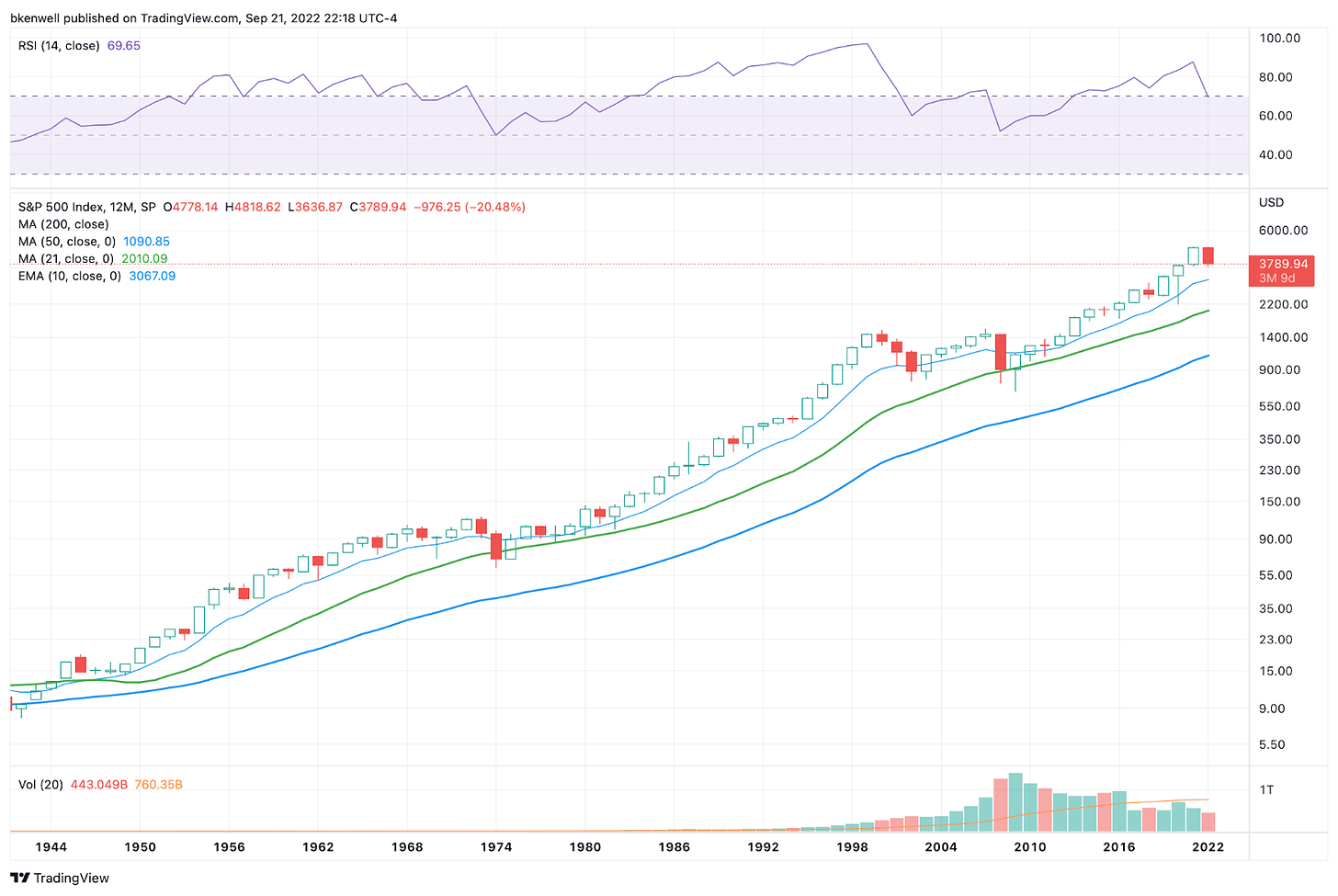Here's the Long-Term Performance of the S&P 500
Why it's important to both traders and investors.
I am just now realizing that I accidentally sent a duplicate post last week of some long-term setup in individual stocks. Sorry about that! I meant for it to be this post.
Here’s the long-term performance of the S&P 500 to help with perspective.
2022 has not been an easy year, not by any stretch of the imagination. Bear markets are not that common in the equities world, but when they come around they can cause a lot of pain. Volatility spikes, emotions run out of control and our assets are under pressure. However, too many people forget the long-term performance of the S&P 500.
To the pessimists, I’m sorry, but being a perma-bear just doesn’t pay.
There’s a big difference between looking at an environment, identifying some red flags and noticing a change in the trend vs. always being Dr. Doom and Gloom. For what it’s worth, being a perma-anything can be damaging to our mental and financial capital at some point along the way.
However, being a perma-bear has been extra damaging once you take a few minutes and look at the long-term numbers.
Humor me for a minute and give the next section a read.
The Long-Term Performance of the S&P 500
I’m going back to 1942, giving us 80 years of data to work with (excluding 2022 at this point). On an annual basis, here’s what we found:
The S&P 500 rose 80% of the time when including dividends
When not including dividends, it rose 75%
The average “up” year was a gain of 16.6%
Including dividends, it was 19.6%
The average “down” year was a loss of 12%
Including dividends, the average loss was 11.75%
The S&P 500 has only declined in three straight years once (from 2000 to 2002)
Has rallied in three straight years (or more) 12 times.
In fact, when including dividends we've had two stretches of nine straight annual gains and one stretch of eight straight yearly gains
In short, we wouldn’t find these odds at a Las Vegas casino. With the S&P 500, we have a “table game” that wins 80% of the time and when it wins, it pays out more than what it takes when it loses.
In other words, you sit down with someone who offers a straightforward bet: They'll flip a coin. If it's heads, they'll pay you $100. If it's tails, you pay them $60. The only "catch" is that the coin lands on heads 80% of the time.
Why wouldn’t you play?

Lastly, the last 80 years isn’t cherry picked, although it does go out of its way to avoid WWII. But even with different stretches, a similar observation is observed. We have the win-rates for the last 20, 30, 40 and 50 years, which are 85%, 83.3%, 85% and 80%, respectively.
So it's a fairly consistent expectation for the S&P 500 to rise about 80% of the time on an annual basis, or about eight out of every 10 years.
The Bottom Line: How Does It Apply?
I believe there are several ways to interpret the above information. Actually, three to be specific.
If you are an investor, obviously this long-term trend is favorable. This is a reassuringly strong trend advocating that we stuff our 401Ks, IRAs and long-term investing accounts and make it a priority to do so. The returns are simply too impressive over the long-term measures.
If you are a trader, please keep in mind the longer term trends. It goes back to one of the key mantra rules of trading: “Don’t fight the trend.” Obviously there can be periods of downtrends and corrections. But generally speaking, this ship is mainly moving in one direction.
For both traders and investors, this is a great example that it doesn’t pay to be a perma-bear. 8 out of every 10 years, the S&P tends to rally. It can be easy to get overly negative, overly pessimistic and too emotional when things go haywire. Instead, remember the long-term trend.
There’s also a lesson in there about diversifying. Profitable traders should be tucking away some of their funds into this favorable long-term trend.
There’s always the caveat that past performance does not indicate future success — we all know this. However, every long-term bear case has been blown to smithereens. Scorching inflation in the 1980s, World Wars, terrorist attacks, a global pandemic and a financial crisis have hit hard at times.
But in general, the world keeps on spinning, workers clock in and clock out and eventually stocks rise. Don’t Forget the Long-Term Trend and ask yourself, “Is this time really any different?”



